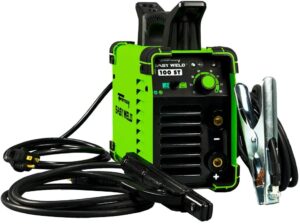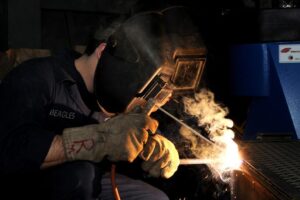by James Anderson | Last Updated on February 17, 2023
 I am a hobbyist welder and I love to do my own welding activities. A long time ago, I used the same equipment for carbon steel and stainless steel welding. As a result, I observed premature corrosion. Besides, as a newbie, I also did not know how to stick weld stainless steel properly?
I am a hobbyist welder and I love to do my own welding activities. A long time ago, I used the same equipment for carbon steel and stainless steel welding. As a result, I observed premature corrosion. Besides, as a newbie, I also did not know how to stick weld stainless steel properly?
Once, one of my friends shared some useful and efficient methods of stainless steel welding. Now, I do not feel any hassle doing welding.
However, stainless steel welding is a little bit complicated. Sometimes it becomes difficult to select the appropriate tool and technique to stick weld stainless steel.
STOP WORRYING!
I present this simple guide to solve your problem and make your welding work done easy.
Table of Contents
About Stick Welding and Stainless Steel
 The stick welding process has also known as shielded metal arc welding. It has used to join the steel pieces by heat and pressure. This technique has mostly used in the maintenance and construction industry.
The stick welding process has also known as shielded metal arc welding. It has used to join the steel pieces by heat and pressure. This technique has mostly used in the maintenance and construction industry.
Stainless steel is low carbon steel but contains chromium (around 11 to 30 percentage) and iron. It is highly corrosion-resistant, also fire and heat-resistant. Stainless steel has used in cooking appliances and accessories. It has widely used for its long-term value, ease of fabrication, and recycle ability.
How to Stick Weld Stainless Steel?
Stick welding is a better choice for your do-it-yourself tasks. You can easily use this technique for joining small pieces at your home. It may seem a bit difficult for you in the beginning. But once you have learned the process – it will become the easiest welding method for you. Stick welding is the perfect option for indoor and outdoor activities. It can use on dusty surfaces and also on metals with corrosion. Besides, it can quickly join the thick pieces.
In the stick welding procedure, an electrode has used to set down the weld. This electrode has a consumable flux-coated layer. Through the process, the steel piece and electrode both melt and create a weld pool. When this weld pool cools down, it will form a robust joint. It performs better on painted surfaces.
Multiple welding techniques are available now. But stick welding is the most budget-friendly and simple among them. So, novice welders can easily do their welding works with this process. Before you start your welding adventure, you should always take safety precautions.
Welding Safety Precautions
- Wear welding helmet with shield and fire-resistant clothes
- Use respirators
- Wear ear protection, boot, and gloves
Essential Things You Need for Stick Welding Stainless Steel
- Stainless steel
- Electrodes
- Electrode holder
- Power supply
- Ground clamp
- Stick welder
Let’s Get Started!
 Stick welding can alternate AC vs. DC. Generally, direct current is better and flexible. For this reason, it has used for both hobbyist and commercial projects. Once you gather all the requirements and take the safety precautions, it’s time to start the procedure.
Stick welding can alternate AC vs. DC. Generally, direct current is better and flexible. For this reason, it has used for both hobbyist and commercial projects. Once you gather all the requirements and take the safety precautions, it’s time to start the procedure.
Step – 1:
Place the electrodes and arcs. Then turn on the power supply, and electric current will start to pass through them. You need to select your power current setting based on the welding position and electrodes. But it is better to follow the manufacturer’s instructions and recommendations.
Step – 2:
Choose the right arc length is essential for stick welding. Not all the electrodes and projects require the same arc length. It may vary. Suppose, for 0.125 inches metal piece requires 0.125 inches 6010 electrodes.
Step – 3:
Once the electrode starts to melt, the electrode’s consumable flux coating will create gas clouds. It will shield the soft steel. Besides, it helps to protect it from oxidization.
Step – 4:
This gas cloud will create a weld pool when it cools down and form a strong joint. During this entire process, you should choose the right angle of traveling arc. If you do not use the correct angle, it will affect travel speed. So, choosing the right angle is important. You can choose the drag method for welding in the flat and horizontal position. If you go for vertical welding, you can apply the push method.
Warning – Remember, it has not recommended for reactive metals. As it cannot protect from oxygen contamination, it is not a good option for reactive metals. Its deposition rate is lower compared to other techniques.
Some Untold Benefits of Stick Welding
- Stick welding is a versatile process, and all the instruments come with an affordable price range.
- It will save you additional money as it does not need any external gas.
- You can easily carry it out during adverse weather conditions.
- It is simple to replace the electrodes for variant types of metal. Besides, it is easy to clean the welds.
- Another significant benefit – you can easily weld a large scale of materials by applying this technique.
Exclusive Tips for Stainless Steel Welding
- If the stainless steel is high in carbon, then you need to preheat it.
- It would help if you moved the welding torch at a particular speed.
- It would help if you used a welding table to avoid potential fire hazards.
- Remember, you should work in a well-ventilated place. But beware, never start to work in a close-off area.
- Do not overuse your welding machine.
Bottom Line
If you want a cost-effective option, the stick welder is the right choice. Also, it is a better choice for the hobbyist and newbie for its affordability and versatility. Besides, it does not require any auxiliary gas. As a result, stick welding also saves you the additional cost. But it is not that much easy for the new welders to work as a professional. Once you practice and learn it, I am sure – you will love this technique. So, follow the steps of how to stick weld stainless steel carefully.
And be a Pro Welder!
Related article:

Hi, I am James Anderson from Sandy, Utah. Welding has always been part of my life and I love to share my wealth of experience. I have a team of professionals who are knowledgeable about different welding processes. I hope you will be educated and informed on this website, to become better welders.
